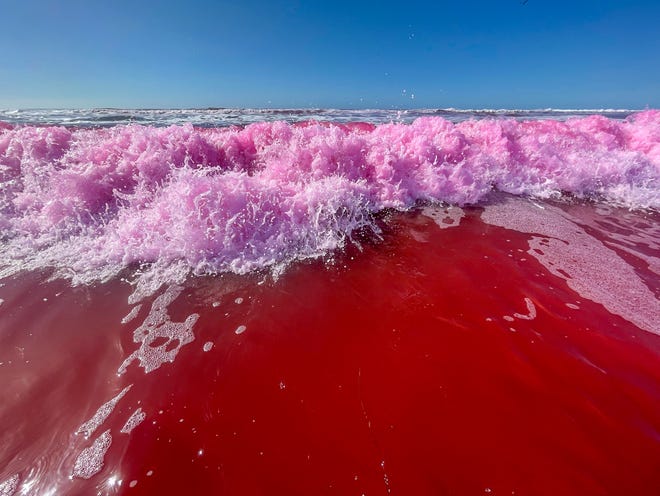There’s something different about the waves at Torrey Pines State Beach in California: they’re pink, temporarily, of course.
The coloring comes from a pink dye that’s part of an experiment to research how small freshwater outflows interact with the surf zone where waves are breaking, said postdoctoral scholar Alex Simpson.
Simpson is part of a team made up of researchers from the University of California San Diego’s Scripps Institution of Oceanography and the University of Washington.
The team’s project is called Plumes in Nearshore Conditions or PiNC. It focuses on the estuary and coastline at Los Peñasquitos Lagoon, a small intermittently closed estuary located between San Diego and Del Mar.
The experiment will give scientists a first-ever look at how waves at the lagoon mix with buoyant plumes, or masses of fresher water that enter saline regions during river outflow, the team said.
The results will also give the team data on the spread of sediment, pollutants, larvae and other materials in environments close to the shore.
What’s with the pink dye?
According to the university, rivers and estuaries are vital in delivering freshwater and materials such as sediments and contaminants to the coastal ocean. However, researchers don’t know much about how plumes of fresher water interact with dense, saltier water and the colder ocean environment.
That’s why the team is releasing an environmentally-friendly pink dye into the mouth of the estuary. They’ll then be able to study what happens when small-scale plumes of freshwater meet the surf zone.
The project involves three dye releases altogether, including:
- A dye release on Jan. 20
- A dye release later in January
- A dye release in early February
All dye releases will be during an ebb tide, or the tidal phase when the water level is falling. This way, the dye is carried out of the estuary into the coastal ocean.

The dye is non-toxic and won’t hurt humans, wildlife or the environment, the team said.
The pink dye will be visible for three to six hours but the team may be able to detect it with sensors for longer, Simpson told USA TODAY.
“It is fluorescent, which means we clearly know the wavelengths of absorbed light and emitted light,” Simpson said. “This makes it possible to quantify dye concentration using various types of underwater and aerial sensors.”
And this isn’t the first time researchers have used pink dye for nearshore experiments, the team said. It has also been used to track beach pollution dynamics near the U.S-Mexico border in 2015.
What’s different about this study?

Sarah Giddings, who is leading the study, said while previous studies have centered around large-scale freshwater plumes with high outflow, smaller-scale plumes that directly interact with the surf zone have been overlooked.
“The environmental impact of having water be trapped instead of going offshore means that all the things that are being carried in the water like pollutants or larvae or sediment is also going to be trapped within,” Giddings said in a video about the project. “It can also be important for pollution.”
This research, funded by the National Science Foundation, may help decision-making such as beach closures after rainfall events, she said.
Dyeing the estuary outflow water pink will help the team visualize it and separate it from the ocean water. From there, they can follow the freshwater out of the estuary and track where it goes.
Because the dye can be seen to the naked eye, a camera-equipped drone will also be able to track the pink water.
In addition to measuring breaking waves, the team is also looking at ocean currents, wave heights, tides, salinity and temperature.
“I am looking forward to seeing how the balance of physical forces—ocean waves competing against river outflow—determine the fate of the estuary water as it enters the coastal ocean on the days that we conduct our field experiment,” Simpson said in a release about the project.

Saleen Martin is a reporter on USA TODAY’s NOW team. She is from Norfolk, Virginia – the 757 – and loves all things horror, witches, Christmas, and food. Follow her on Twitter at @Saleen_Martin or email her at sdmartin@usatoday.com.

